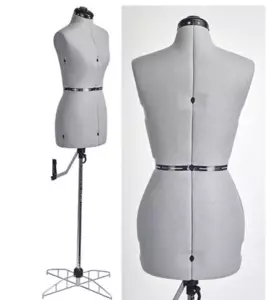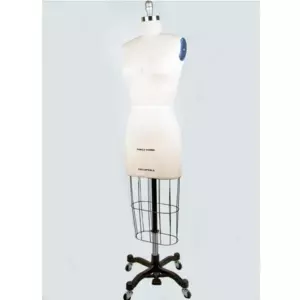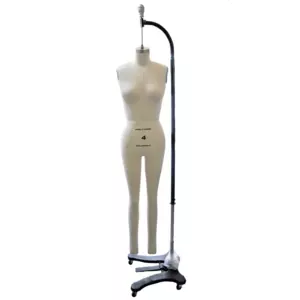Why Use a Dress or Body Form? Why Not Use One?
Home Sewing Dress Forms
For the home sewer, it can be challenging to fit a garment on yourself without a helper. If you’re going at it alone, a form body can help you when making hems and adjustments. You can see how a fabric will look when it’s hanging on a body (yours or anyone else’s), and you’ll have an idea of the fabric’s drape capabilities. For garments in the process of construction, it’s easier to see than working with a garment on a hanger. And many come with hem markers to make it even easier to finish your garment perfectly.
Professional Sewing With A Body Form
For the designer who is creating and manufacturing their own products, dress and body forms allow for the 3-dimensional research and design of garments. When designing a new pattern, a dress or body form is useful for not only creating but fitting and adjusting before finalizing a design.
Draping is another method of patternmaking design that takes into account elements that are difficult to do with flat patternmaking. Elements like ruching, cowls, and asymmetrics are easier to create when they can be draped, tied, and moved around on a form before creating a flat pattern.
Working With A Body Form
A body form or form mannequin can be used to create a wide range of projects, from wedding gowns to safety clothing and gear. Nearly anything that is stitched can benefit from the use of a form body.
Before you spend any money, you’ll need to figure out precisely what you want to do with it, since there are a few different types.
Will you just be making dresses, skirts, tops or shirts? Will you create a maternity line, or add it to your current design lines? What about men and boys—will you be creating garments for them as well?
Depending on your needs, you can choose from:
- Professional Dress Forms have a hard interior and a softer exterior. They are available in a wide range of sizes and body types. At GoldStar Tool, we carry:
- Female Dress Forms with and without hip and collapsible shoulders
- Missy full-body dress forms including legs
- Family body forms
- Pants forms, ladies, girls, and men
- Mature men and mature women forms
- Pregnant dress form as well as a pregnancy pillow for adding a belly
- Magnetic arms, both left, and right (sold individually)
- Half-scale and miniature scale forms for women, half-scale for men
- Full Body Dress Forms, including legs for pants and suits
- Bifurcated Dress Forms, useful for pants for women, girls, men, and boys
- Adjustable dress forms, foam backed models with dials for changing measurements that are most frequently used by home sewers to get a custom fit. You can change individual measurements with dials that go up or down within a size range. Both our red adjustable and grey Adjustable forms feature dials to change sizes and hem markers for easy hemming. Order yours according to your current size, and adjust as needed.
- Half-Scale dress and body forms are primarily used by students who are learning how to do fitting and draping, as well as display models for clothing designs and jewelry.
- Bridal Professional Dress Forms have adjustable bases that are made from cast iron, from sizes 2 through 6 (arms are also available for an additional cost.)
What To Look For In A Form Body For Sewing
Do you know what to look for when selecting and buying a dress form or body form?
If you’re seriously considering buying a body form of any kind, look for one that:
- Is sturdy with a metal base
- Can be moved and turned easily (some have casters for rolling)
- You can stick pins into
- Has adjustable height that you can easily change as needed
- Contains standard markings for draping and fitting
Boutique and shop owners may be more interested in body and dress forms to display both apparels, jewelry, and accessories. Seeing a beautiful dress form in your studio can also inspire your designs or serve as a backdrop for your editorial photoshoots.
Sewing bloggers may also consider a sewing or body form to display their crafts for photos, as well as for designing, draping, and fitting.
Dress And Body Form As Tools
For the professional, a dress or body form is much more than a prop; it’s an investment in his or her business.
Dress forms are an essential part of your design studio or toolkit. Your patterns need to be accurate and often replicable, and only an exact dress form can assist with that.
GoldStar Tool For The Best Selection Of Sewing Body Forms And Dress Forms
We carry a diverse collection of dress forms for women, men and children, as well as full-figured forms, maternity forms and pillows, small-scale dress forms, and partial forms such as arms that can attach to a dress form.
If you’re considering dress forms for your home or business, you can see and buy our complete collection on our website. If you’re not sure which one is right for you, call us at 1-800-868-4419. We’ll be happy to discuss your needs and help you select the right sewing body form or dress form.








